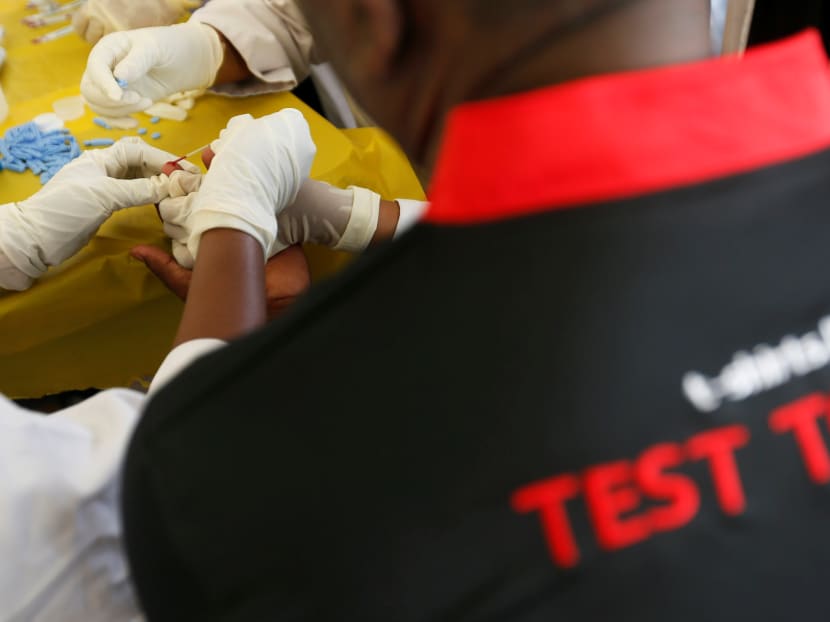‘I thought I was going to die’: HIV patient recounts 30-year battle managing condition
SINGAPORE — Thirty years ago, Mr Lawrence Ang (not his real name) was diagnosed with the human immunodeficiency virus (HIV), kick starting a medical journey that saw him developing severe side effects from popping 15 pills a day.

Today, HIV treatment has evolved and improved significantly from what was available decades ago, said doctors and patients.
SINGAPORE — Thirty years ago, Mr Lawrence Ang (not his real name) was diagnosed with the human immunodeficiency virus (HIV), kick starting a medical journey that saw him developing severe side effects from popping 15 pills a day.
The cocktail of medication to keep his viral load — the amount of HIV in his blood — in check caused him to feel nauseous constantly and gave him insomnia.
While some HIV patients develop sunken cheeks due to a side effect called lipodystrophy, he ate a healthy diet and worked out in the gym to lessen its effect on his body.
At one phase, he also experienced strange dreams and displayed signs of depression.
Today, HIV treatment has evolved and improved significantly from what was available decades ago, said doctors and patients.
“(Today’s HIV patients) are diagnosed in an era where medication is superior, side effects are minimal and their quality of life is so much better than before,” said Mr Ang, who is now 56.
“Their battle is much easier than what I went through. I can tell you this because I went through the worst.”
Mr Ang runs a club that buys cheaper HIV medication from other countries and sells them to patients here at more affordable prices, under advocacy group Action for Aids (AFA).
Keeping the virus at bay today involves popping one pill a day and the side effects are “practically non-existent”, said infectious disease expert Leong Hoe Nam.
Three years ago, the authorities approved the distribution and use of Triumeq, which required patients to take only one pill a day and had minimal side effects.
In a further boost to people living with HIV, the Health Sciences Authority (HSA) on Thursday (Feb 14) approved another one-pill option, Biktarvy. Unlike Triumeq, users do not need to undergo a blood test before starting this course of medicine. The drug is produced by biopharmaceutical firm Gilead Sciences.
Dr Leong said Biktarvy is a “re-engineered” version of Truvada, which is currently the most widely-adopted medicine among HIV patients and used for HIV prevention. Users do not experience side effects such as bone and kidney problems.
Other than Singapore, only the United States, Hong Kong and the European Union have approved the use of Biktarvy so far.
“If you were diagnosed in the 1990s, chances were only 10 per cent would live to a ripe old age. A person who is diagnosed with HIV now, I expect the person to live as long as you or me,” said Dr Leong who practices at Rophi Clinic in Mount Elizabeth Novena Hospital.
According to the latest statistics from the Ministry of Health, more than 6,000 Singapore residents were HIV-positive as of end 2017, with the number of new cases remaining constant at about 450 a year since 2008.
NARROW ESCAPE FROM DEATH
Calling himself “one of the 80’s dinosaurs that survived”, Mr Ang told TODAY that he was diagnosed in 1989 when the chances of surviving the condition were still bleak. Just two years prior, Freddie Mercury, lead singer of rock band Queen, had been diagnosed with HIV and his death in 1991 due to complications from acquired immunodeficiency syndrome (Aids) made headlines worldwide.
Mr Ang was 26 years old when he tested positive for HIV and his doctor told him he had at most seven years to live.
He was first treated with the drug AZT (Zidovudine) which gave him nausea and cold chills.
“I thought I was going to die,” he said, adding that he started planning his own funeral and drafting his will in 1993. He also quit his advertising job and started volunteering with AFA.
In 1996, he was saved in the nick of time by a new, powerful triple drug cocktail treatment comprising a combination of AZT, 3TC (Lamivudine) and Saquinavir.
As there were multiple pills to be taken as frequently as five times a day, he would set his stopwatch to remind him to take his medication, he said.
In three months, he gained 10kg — from 48kg to 58kg — and his viral load plunged from close to a million copies per millilitre to about 8,000. After another three months, that was contained to 40 and under copies per millilitre, which meant that his condition was untransmittable.
SIDE EFFECTS: FROM BAD TO WORSE
While the medication worked for Mr Ang, the nausea did not stop. He also suffered from insomnia and woke up hourly during the night.
Two years after starting the treatment, his body developed an immunity to it and his viral load started to shoot up.
He then turned to a new combination of drugs containing Crixivan, Didanosine and 3TC.
The “horrible” treatment gave him a “disfigured body” such as sunken cheeks and a buffalo hump — a fat pad on his upper back and neck area — and non-stop bouts of nausea.
There were also other side effects, as he added: “I get sad dreams... Depressive dreams to do with my childhood. Thankfully, I am a strong-willed and determined person.”
He also started to show signs of depression and had to see a psychologist.
In 2003, Mr Ang started a new regimen of drugs — a combination of Viracept, Nevirapine and 3TC — which did not have as many side effects but were not effective after four years.
LEADING A NORMAL LIFE
In 2007, he switched to a drug combination of Truvada, Atazanavir and Ritonavir and stayed on the treatment for 10 years. He no longer experienced physical side effects such as nausea.
This marked the start of an era of HIV treatments in this decade that are convenient and well tolerated by patients, said Dr Leong. The next step would be treatments that need to be administered only once a month or every three months, he added, noting that a "long-acting injection" is currently being developed by pharmaceutical firm GlaxoSmithKline.
Now, Mr Ang takes a “fourth-generation drug”, a combination of Tivicay, TAF (Tenofovir alafenamide) and 3TC which he felt would less likely cause kidney problems.
“That’s the best. The side effects are zero. I take one pill a day,” he said.
His CD4 white blood cell count also increased to 850 cells per cubic millimeter of blood, which was “the highest in my lifetime of treatment”, added Mr Ang.
After a rollercoaster journey that spanned 30 years, Mr Ang is relieved that he is now able to lead a normal life like anyone else.
“If there is any conquest in my life, overcoming all these is more than anything one can achieve. I feel so accomplished because these are life-saving drugs that you overcome (the condition) with,” he said.








